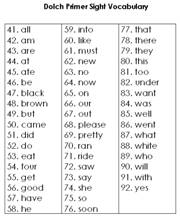 Sight words are words that should be immediately recognisable. The ability to recognise a large number of words instantly and automatically enables students to read without frequent pauses. They can concentrate on the message of the text instead of making extra effort to analyse the meaning of individual words while reading, which in turn helps improve their overall comprehension of the text. Sight words are words that should be immediately recognisable. The ability to recognise a large number of words instantly and automatically enables students to read without frequent pauses. They can concentrate on the message of the text instead of making extra effort to analyse the meaning of individual words while reading, which in turn helps improve their overall comprehension of the text.
In the 1940s, Edward W. Dolch did an extensive survey of first grade to third grade books. He compiled lists of the words which were most frequently found in these levels: pre-primer, primer, first grade, second grade, and third grade. He listed out 220 service words that are pronouns, adjectives, adverbs, prepositions, conjunctions and verbs, and also 95 nouns which occurred over and over again in children’s books.
The 220 Dolch Words make up between 50 and 70% of the text in children's reading material. So, students learning the Dolch Words were able to recognise the majority of the words in any general non-technical text. One may think that the teaching of phonics ought to be fundamental for the learning of vocabulary. It is true but many of the sight words do not follow the phonetic rules, e.g., to vs go, no, so; said vs maid, paid; many of them cannot be sounded out by decoding rules, e.g., to, too, two. And many of them look similar, e.g., on, no; of, for, from; was, saw. The lists also include frequently used irregular verbs: go, went; do, did; is, was. All these words cannot be worked out using rules and must be recognised at sight.
It is essential to note that, though the teaching of sight words has its crucial importance, it should not replace a phonics programme as each contributes a different kind of support to the learning of English vocabulary. |

